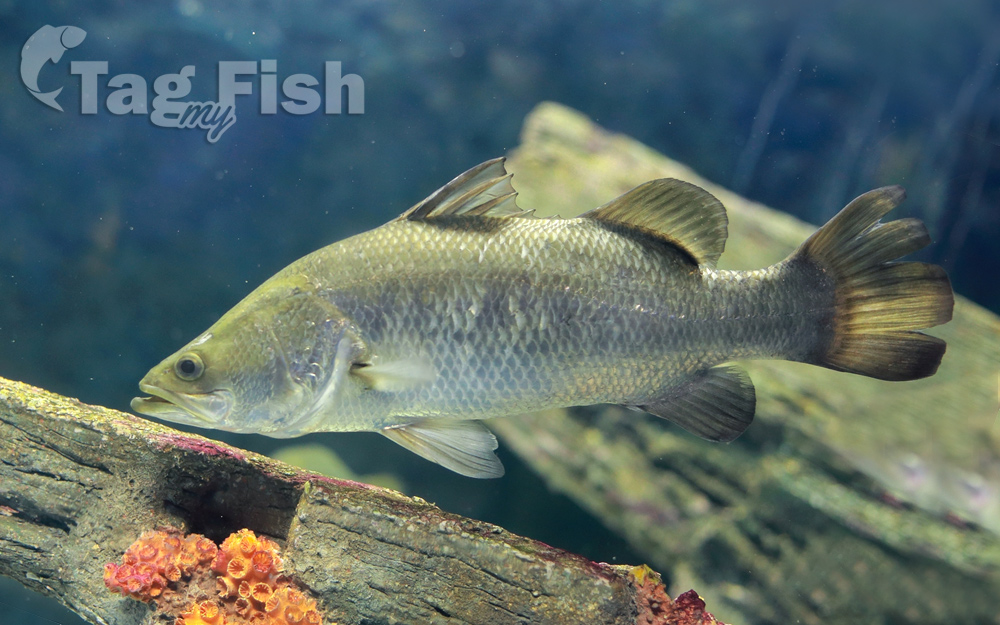Silver perch
(Bidyanus bidyanus)

General data
The silver perch (Bidyanus bidyanus) is a medium-sized freshwater fish of the family Terapontidae endemic to the Murray-Darling river system in south-eastern Australia.
They are the largest member of the Terapontidae, capable of growing in excess of 60 cm (24 in) and close to 8 kg (18 lb), but today wild river specimens are typically 30–40 cm (12–16 in) and 1.0–1.5 kg (2.2–3.3 lb).
The silver perch is the only major representative of the family Terapontidae in the southern Murray-Darling system, compared to northern tropical systems where terapontid species are common. Another small terapontid, the spangled perch (Leiopotherapon unicolor), does occur sporadically in the northern Murray-Darling Basin.
Common names for Bidyanus bidyanus include silver perch, black or silver bream and the traditional bidyan.
Description
The silver perch is a large grunter with a small head, small eyes, a small mouth at the end of a pointed beak-like snout. The species is streamlined and laterally compressed, with a spiny dorsal fin of medium height, angular soft dorsal and anal fins and a forked tail. Large specimens become very deep bodied with a large hump behind the head. In terms of coloration, they are dark grey to silvery greyish-brown on the back, silver-grey on the sides, with darker scale margins giving a checkered pattern; the belly is whitish; the dorsal and caudal fins are dark, the pelvic fins white.
Diet
Silver perch are opportunistic feeders, feeding on insect larvae, molluscs, annelid worms and algae. The importance of vegetative matter in the diet of silver perch is still debated. Silver perch appear primarily to be a low-order predator of small aquatic invertebrate prey, with occasional intakes of small fish and vegetative matter. In aquaria, silver perch are reported to take blood worms readily.
Distribution
Silver perch are schooling mid-water fish with a preference for flowing water. Though nowadays found in the lowland reaches of the Murray-Darling system, they originally had a strong presence in the slope and upland reaches of many Murray-Darling rivers as well. In particular, they had a strong presence in upland reaches of the Murrumbidgee River and were originally found as far upstream as Cooma. As recently as the early 1980s, long summer migrations into the upland reaches of the Murrumbidgee were an annual event. Unfortunately, these migrations, and these populations, have now collapsed - silver perch are functionally extinct in the Murrumbidgee River now, as in most parts of their former range.
Silver perch have been introduced into the Lake Eyre Basin in arid central Australia. These releases were not officially sanctioned and pose serious hybridisation risks to closely related species of terapontids endemic to the Lake Eyre system.
A translocated and reproducing population of silver perch exists in Cataract Dam on the Hawkesbury-Nepean system. This population was established by NSW Fisheries translocations of juvenile fish from drying billabongs in the lower Murrumbidgee River in approximately 1915–17. The Cataract Dam population is unique in being the only population of silver perch in an artificial impoundment that regularly and successfully recruits and is self-sustaining. The long established prohibition on fishing, the consequent absence of exotic fish and their diseases, and the pristine nature of the dam, including a largely undisturbed, thickly-forested catchment and an abundance of coarse rubble and gravel in many inshore areas, where fertilised eggs can settle and not be smothered by silt, are all likely contributors to this unique situation.[
Fishing
Fishermen caught silver perch on unweighted baits such as worms and on small spinning-blade lures in rapids during migrations into upland rivers, as well as flowing and moving waters more generally. They were renowned for being very fast and strong fighting fish.










